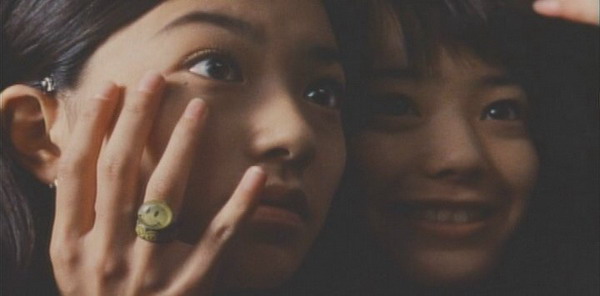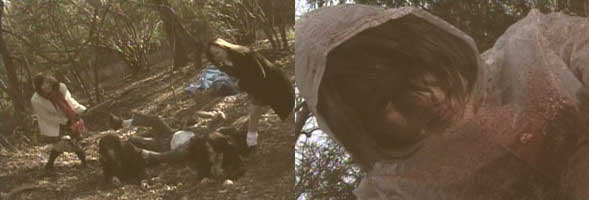

J-Horror Girls
“Come at me. Every inch of me will resist
you!” (Chiaki Kuriyama, “Battle Royale”)
The mid-1990s saw the production of the popular
“Gakko no kaidan” (“Haunted School”) directed by Hideyuki Hiriyama, the
first in a series of ghost stories that eventually featured high school
adolescents. Some of these tales were apparently based on the urban
legend of Hanako, the spirit of a girl supposedly inhabiting a school toilet.
Makoto Yamaguchi’s “A Frightful School Horror” (2001) continued in this
vein. The third and best of the three short films comprising this
title invokes the eerie qualities of a deserted high school bathroom while
exploring the superstitions, friendships and rivalries among high school
girls. Other films that introduced an unsettling blend of “shojodo”
(“the way” of the schoolgirl) and horror themes involving the uncanny included
Shimako Sato’s “Eko eko azaraku” (“Wizard of Darkness,” 1995) and its sequels
in the “Misa Kuroi” trilogy, Yukihiko Tsuzumi’s “Toire no Hanako-san” (“Hanako,”
1998) as well as Ataru Oikawa’s “Tomie” (1999) and its sequels. Tetsuo
Shinohara’s “Shisha no gakuensai” (“School Day of the Dead,” 2000) culminated
this cycle by returning to the original Hanako theme of a female high school
student who committed suicide as the origin of uncanny events in a school
setting. Takahisa Zeze’s “Kokkuri-san” (“Kokkuri,” 1997) features
three high school girls who dabble in the then-popular Ouija-like fortune-telling
activity. They listen to a nightly radio show whose host conjures
up a fortune-telling spirit that forecasts one of the girls’ deaths.
Kazuyuki Shibuya’s “Shibito no koiwazurai” (“Lovesick Dead,” 2001) combined
high school love triangles and the curse of the “Tsujiuranai no Bishonen”
to produce a variant of morbid wish fulfillment leading to suicide.
Toshiharu Ideka’s “Ikisudama” (“Shadow of the Wraith,” 2001) is actually
two shorter films that, like “Lovesick Dead,” featured sisters Hitomi and
Asumi Miwa who have become regulars of J-Horror. In “Shadow of the
Wraith” they respectively pursue high school love interests as a stalker
and savior from haunting. Ryu Kaneda’s “Boogiepop wa warawanai” (“Boogiepop
and Others,” 2000) is a disarmingly appealing tale of the collision between
spirits for evil and good in the bodies of adolescent girls (including
Asumi Miwa) enacted in the context of high school relationships.
 Many of the narratives in this sub-genre are grounded
on the suicide or sacrifice of adolescent girls. These acts are sited
at the confluence of three subtexts – female sexuality and its cultural
constraints, dishonor, and suicide. Adolescence is itself a culturally
defined boundary that offers ample scope for examination of these horror
themes that resonate with Okiku’s plunge into the well, and a number of
popular female performers star in several of these otherwise modest productions.
Hitomi Miwa is particularly noteworthy as the emergent “scream queen” of
J-Horror. With parts in films such as Shinji Aoyama’s “Enbamingu”
(“Embalming,” 1999), the V-movie “Ju-on” (2000), Hirohisa Sasaki’s “Hakkyousuru
kuchibiru” (“Crazy Lips,” 2000), “Shadow of the Wraith” (2001) and Takeshi
Miyazaka’s “Genkaku” (“Hallucination,” 2005), she has displayed a range
of acting talent extending beyond schoolgirl typecasting.
Many of the narratives in this sub-genre are grounded
on the suicide or sacrifice of adolescent girls. These acts are sited
at the confluence of three subtexts – female sexuality and its cultural
constraints, dishonor, and suicide. Adolescence is itself a culturally
defined boundary that offers ample scope for examination of these horror
themes that resonate with Okiku’s plunge into the well, and a number of
popular female performers star in several of these otherwise modest productions.
Hitomi Miwa is particularly noteworthy as the emergent “scream queen” of
J-Horror. With parts in films such as Shinji Aoyama’s “Enbamingu”
(“Embalming,” 1999), the V-movie “Ju-on” (2000), Hirohisa Sasaki’s “Hakkyousuru
kuchibiru” (“Crazy Lips,” 2000), “Shadow of the Wraith” (2001) and Takeshi
Miyazaka’s “Genkaku” (“Hallucination,” 2005), she has displayed a range
of acting talent extending beyond schoolgirl typecasting.
 Narratives involving teenaged girls who are killed
by others – often marginalized male figures – are, of course a staple of
that branch of horror films that have come to be known as slashers.
While many horror films subject female characters to assault, suffering,
or death, slashers seem especially frank in equating adolescent sexuality
with retributive death. This, perhaps, connotes the highly conservative
social message that young women should not really be in possession of their
bodies and sexuality. Autonomy – at least of a certain kind – is
severely sanctioned in these films.
Narratives involving teenaged girls who are killed
by others – often marginalized male figures – are, of course a staple of
that branch of horror films that have come to be known as slashers.
While many horror films subject female characters to assault, suffering,
or death, slashers seem especially frank in equating adolescent sexuality
with retributive death. This, perhaps, connotes the highly conservative
social message that young women should not really be in possession of their
bodies and sexuality. Autonomy – at least of a certain kind – is
severely sanctioned in these films.
 The relatively few J-Horror titles that follow
the familiar slasher formula appear almost brutally explicit in their adherence
to its conventions. Hitoshi Ishikawa’s “Shuudan satsujin club” (“Big
Slaughter Club,” 2003) and its three sequels and Kengo Kaji’s teenage haunted
house “Buraddi naito has gôgô” (Bloody Night a Go Go,” 2004)
prominently feature helpless young female victims. Zenboku Sato’s
“Oshikiri” (2000) is another mysterious mansion film. “Big Slaughter
Club” involves high school girls who sell their underwear and act as prostitutes
– ostensibly to steal their middle-aged customer’s wallet. After
this scam derails and the john is accidentally killed with his head impaled
on a coat hook, the enterprising girls plug the head wound with a tampon
before carting him off to be dismembered. His re-animated corpse
returns to kill them all in various ingenious ways. This so clearly
articulates the punitive moral code of slashers. The “Tomie” series
is an interesting and perhaps culturally specific conflation of slasher
and suicide films, since “Tomie” essentially provokes her own killing.
The relatively few J-Horror titles that follow
the familiar slasher formula appear almost brutally explicit in their adherence
to its conventions. Hitoshi Ishikawa’s “Shuudan satsujin club” (“Big
Slaughter Club,” 2003) and its three sequels and Kengo Kaji’s teenage haunted
house “Buraddi naito has gôgô” (Bloody Night a Go Go,” 2004)
prominently feature helpless young female victims. Zenboku Sato’s
“Oshikiri” (2000) is another mysterious mansion film. “Big Slaughter
Club” involves high school girls who sell their underwear and act as prostitutes
– ostensibly to steal their middle-aged customer’s wallet. After
this scam derails and the john is accidentally killed with his head impaled
on a coat hook, the enterprising girls plug the head wound with a tampon
before carting him off to be dismembered. His re-animated corpse
returns to kill them all in various ingenious ways. This so clearly
articulates the punitive moral code of slashers. The “Tomie” series
is an interesting and perhaps culturally specific conflation of slasher
and suicide films, since “Tomie” essentially provokes her own killing.
 Unlike even the Final Girls in Hollywood-inspired
slashers, a number of Japanese horror films examine schoolgirls as violent
killers – a most extreme violation of social norms. “Shojodo” finds
its ultimate pairing with absurdist violence in Kinji Fukusaku’s “Batoru
rowaiaru” (“Battle Royale,” 2000) and its derivative “Kiru Onigokko” (“Kill
Devil,” 2004), directed by Yuichi Onuma, in which school students are sent
to a deserted island to participate in a murderous game called “Tag.”
High school girls eagerly chop up a body in “Big Slaughter Club.”
Chiaki Kuriyama’s memorable cameo as a psychopathic killer “Go-go Yubari”
in Quentin Tarantino’s “Kill Bill Vol. 1” might be regarded as a parody
of such narratives.
Unlike even the Final Girls in Hollywood-inspired
slashers, a number of Japanese horror films examine schoolgirls as violent
killers – a most extreme violation of social norms. “Shojodo” finds
its ultimate pairing with absurdist violence in Kinji Fukusaku’s “Batoru
rowaiaru” (“Battle Royale,” 2000) and its derivative “Kiru Onigokko” (“Kill
Devil,” 2004), directed by Yuichi Onuma, in which school students are sent
to a deserted island to participate in a murderous game called “Tag.”
High school girls eagerly chop up a body in “Big Slaughter Club.”
Chiaki Kuriyama’s memorable cameo as a psychopathic killer “Go-go Yubari”
in Quentin Tarantino’s “Kill Bill Vol. 1” might be regarded as a parody
of such narratives.
 In Japanese horror, therefore, female characters
may be accorded not one role (victim) but three – as victim, aggressor
or suicide. This might suggest that while Western horror ritualistically
seeks dominion over female sexuality, Japanese horror might be equally
concerned with various manifestations of lethality as means of resolving
violations of social obligations and personal honor.
In Japanese horror, therefore, female characters
may be accorded not one role (victim) but three – as victim, aggressor
or suicide. This might suggest that while Western horror ritualistically
seeks dominion over female sexuality, Japanese horror might be equally
concerned with various manifestations of lethality as means of resolving
violations of social obligations and personal honor.









